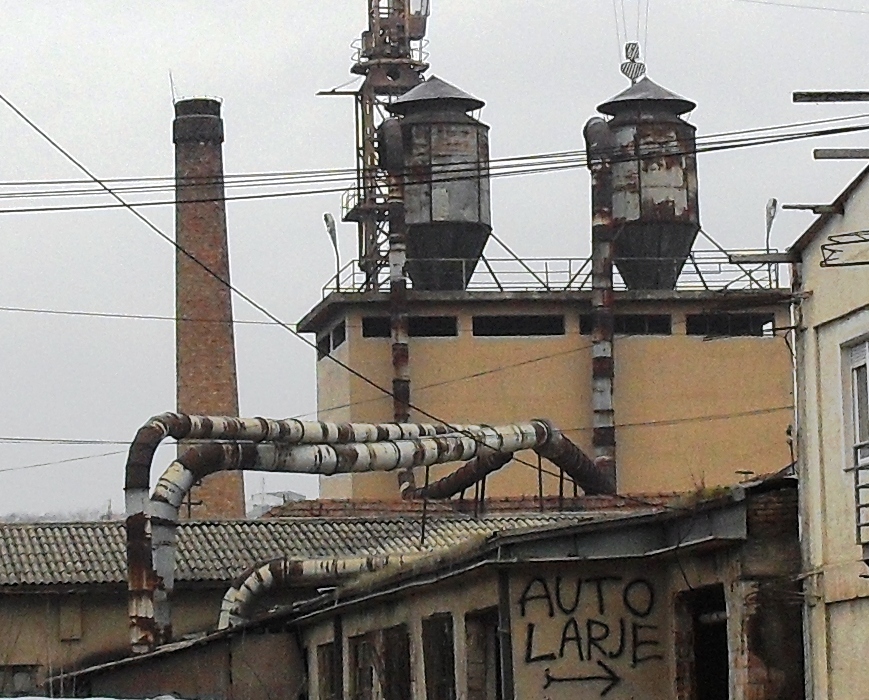|
Random Orbital Sander
A random orbital sander (also known as a palm sander) is a hand-held power tool which sands in a random-orbit action. That is, in constant irregular overlapping circles. This technology was first commercially utilized in 1968 by Rupes Tools. Random orbital sanders combine the speed and aggressiveness of a belt sander with the ability to produce a finer finish than that available from a standard, slow speed orbital finishing sander. Random orbital sanders generally come in three different types: electric powered, air powered, and orbital floor sanders. The electric and air powered orbital sanders are handheld, while the floor orbital sanders are large machines that roll. The random orbit sanding pattern is produced by simultaneously spinning the sanding disk and moving it in small ellipses. This ensures that no single part of the abrasive material travels the same path twice during the same rotation. Because of this random sanding action, the tool does not leave swirl marks, and i ... [...More Info...] [...Related Items...] OR: [Wikipedia] [Google] [Baidu] |
Power Tool
A power tool is a tool that is actuator, actuated by an additional engine, power source and mechanism (engineering), mechanism other than the solely manual labour, manual labor used with hand tools. The most common types of power tools use electric motors. Internal combustion engines and compressed air are also commonly used. Tools directly driven by working animal, animal power are not generally considered power tools. Power tools can produce large amounts of particulates, including ultrafine particles. Airborne particulate matter is a Group 1 carcinogen. Uses Power tools are used in industry, in construction, in renovation, in the garden, for Homemaking, housework tasks such as Outline of food preparation#Food preparation techniques, cooking, housekeeping, cleaning, and Do it yourself, around the house for purposes of driving (fasteners), drilling, saw, cutting, shaping, sander, sanding, Grinding (abrasive cutting), grinding, router (woodworking), routing, polishing, painting, me ... [...More Info...] [...Related Items...] OR: [Wikipedia] [Google] [Baidu] |
Sander
A sander is a power tool used to smooth surfaces by abrasion with sandpaper. Sanders have a means to attach the sandpaper and a mechanism to move it rapidly contained within a housing with means to handhold it or fix it to a workbench. Woodworking sanders are usually powered electrically, and those used in auto-body repair work are usually powered by compressed air. There are many different types of sanders for different purposes. Multipurpose power tools and electric drills may have sander attachments. Types Types of power sanders include: * Belt sander (hand-held or stationary) * Detail sander: A hand-held sander that uses a small vibrating head with a triangular piece of sandpaper attached. Used for sanding corners and very tight spaces. Also known as "mouse" or "corner" sanders. * Disc sander: A disc sander is most commonly implemented as a stationary machine that consists of a replaceable circular shaped sandpaper attached to a wheel turned by an electric motor or compr ... [...More Info...] [...Related Items...] OR: [Wikipedia] [Google] [Baidu] |
Belt Sander
A belt sander or strip sander is a sander used in shaping and finishing wood and other materials. It consists of an electric motor that turns a pair of drums on which a continuous loop of sandpaper is mounted. Belt sanders may be handheld and moved over the material, or stationary (fixed), where the material is moved to the sanding belt. Stationary belt sanders are sometimes mounted on a work bench, in which case they are called bench sanders. Stationary belt sanders are often combined with a disc sander. Belt sanders can have a very aggressive action on wood and are normally used only for the beginning stages of the sanding process, or used to rapidly remove material. Sometimes they are also used for removing paints or finishes from wood. Fitted with fine grit sand paper, a belt sander can be used to achieve a completely smooth surface. Stationary belt sanders are used for removing non-ferrous metals, such as aluminum. Non-ferrous metals tend to clog grinding wheels, quic ... [...More Info...] [...Related Items...] OR: [Wikipedia] [Google] [Baidu] |
Orbital Finishing Sander
A sander is a power tool used to smooth surfaces by abrasion with sandpaper. Sanders have a means to attach the sandpaper and a mechanism to move it rapidly contained within a housing with means to handhold it or fix it to a workbench. Woodworking sanders are usually powered electrically, and those used in auto-body repair work are usually powered by compressed air. There are many different types of sanders for different purposes. Multipurpose power tools and electric drills may have sander attachments. Types Types of power sanders include: * Belt sander (hand-held or stationary) * Detail sander: A hand-held sander that uses a small vibrating head with a triangular piece of sandpaper attached. Used for sanding corners and very tight spaces. Also known as "mouse" or "corner" sanders. * Disc sander: A disc sander is most commonly implemented as a stationary machine that consists of a replaceable circular shaped sandpaper attached to a wheel turned by an electric motor or compre ... [...More Info...] [...Related Items...] OR: [Wikipedia] [Google] [Baidu] |
Wood Grain
Wood grain is the longitudinal arrangement of wood fibers or the pattern resulting from such an arrangement. It has various derived terms refer to different aspects of the fibers or patterns. Wood grain is important in woodworking and it impacts aesthetics. Definition and meanings Wood grain is the longitudinal arrangement of wood fibers or the pattern resulting from such an arrangement. R. Bruce Hoadley wrote that ''grain'' is a "confusingly versatile term" with numerous different uses, including the direction of the wood cells (e.g., ''straight grain'', ''spiral grain''), surface appearance or figure, growth-ring placement (e.g., ''vertical grain''), plane of the cut (e.g., ''end grain''), rate of growth (e.g., ''narrow grain''), and relative cell size (e.g., ''open grain'').Hoadley, R. Bruce. "Glossary." ''Understanding Wood: A Craftsman's Guide to Wood Technology''. Newtown, Conn.: Taunton, 1980. 265. Print. Physical aspects Grain in growing wood follows the grown fibres o ... [...More Info...] [...Related Items...] OR: [Wikipedia] [Google] [Baidu] |
Sandpaper
upright=1.35, Sheets of sandpaper with different grit sizes (40 (coarse), 80, 150, 240, 600 (fine)) Sandpaper, also known as coated abrasive or emery paper, is a type of material that consists of sheets of paper or cloth with an abrasive substance glued to one face. In the modern manufacture of these products, sand and glass have been replaced by other abrasives such as aluminium oxide or silicon carbide. It is common to use the name of the abrasive when describing the paper, e.g. "aluminium oxide paper", or "silicon carbide paper". There are many varieties of sandpaper, with variations in the paper or backing, the material used for the grit, grit size, and the bond. Sandpaper is produced in a range of grit sizes and is used to remove material from surfaces, whether to make them smoother (for example, in painting and wood finishing), to remove a layer of material (such as old paint), or sometimes to make the surface rougher (for example, as a preparation for gluing). The grit ... [...More Info...] [...Related Items...] OR: [Wikipedia] [Google] [Baidu] |
Dust Collection System
A dust collector is a system used to enhance the quality of air released from industrial and commercial processes by collecting dust particle and other impurities from air or gas. Designed to handle high-volume dust loads, a dust collector system consists of a blower, dust filter, a filter-cleaning system, and a dust receptacle or dust removal system. It is distinguished from air purifiers, which use disposable filters to remove dust. History The father of the dust collector was from Lübeck. In 1921, he patented three filter designs that he had pioneered to remove dust from air. Uses Dust collectors are used in many processes to either recover valuable granular solid or powder from process streams, or to remove granular solid pollutants from exhaust gases prior to venting to the atmosphere. Dust collection is an online process for collecting any process-generated dust from the source point on a continuous basis. Dust collectors may be of single unit construction, or a colle ... [...More Info...] [...Related Items...] OR: [Wikipedia] [Google] [Baidu] |
Hook And Loop
Hook-and-loop fasteners, commonly known as Velcro (a genericized trademark), hook-and-pile fasteners or touch fasteners are versatile fastening devices that allow two surfaces to be repeatedly attached and detached with ease. Invented in the mid-20th century, they are widely used in clothing, accessories, and various industrial and consumer applications. The fastener consists of two complementary components: one with tiny hooks and the other with soft loops. When pressed together, the hooks catch the loops, creating a secure but temporary bond. The fasteners can be separated by peeling or pulling the surfaces apart, often producing a distinctive ripping sound. History The original hook-and-loop fastener was conceived in 1941 by Swiss engineer George de Mestral, which he named velcro.The word Velcro is a portmanteau of two French words: "velours" meaning velvet, and "crochet" meaning hook. The idea came to him one day after he returned from a hunting trip with his dog in the A ... [...More Info...] [...Related Items...] OR: [Wikipedia] [Google] [Baidu] |
Vacuum
A vacuum (: vacuums or vacua) is space devoid of matter. The word is derived from the Latin adjective (neuter ) meaning "vacant" or "void". An approximation to such vacuum is a region with a gaseous pressure much less than atmospheric pressure. Physicists often discuss ideal test results that would occur in a ''perfect'' vacuum, which they sometimes simply call "vacuum" or free space, and use the term partial vacuum to refer to an actual imperfect vacuum as one might have in a laboratory or in space. In engineering and applied physics on the other hand, vacuum refers to any space in which the pressure is considerably lower than atmospheric pressure. The Latin term ''in vacuo'' is used to describe an object that is surrounded by a vacuum. The ''quality'' of a partial vacuum refers to how closely it approaches a perfect vacuum. Other things equal, lower gas pressure means higher-quality vacuum. For example, a typical vacuum cleaner produces enough suction to reduce air pressur ... [...More Info...] [...Related Items...] OR: [Wikipedia] [Google] [Baidu] |
Shop Vac
A vacuum cleaner, also known simply as a vacuum, is a device that uses suction, and often agitation, in order to remove dirt and other debris from carpets, hard floors, and other surfaces. The dirt is collected into a dust bag or a plastic bin. Vacuum cleaners, which are used in homes as well as in commercial settings, exist in a variety of sizes and types, including stick vacuums, handheld vacuums, upright vacuums, and canister vacuums. Specialized shop vacuums can be used to clean both solid debris and liquids. Name Although ''vacuum cleaner'' and the short form ''vacuum'' are neutral names, in some countries (UK, Ireland) '' hoover'' is used instead as a genericized trademark, and as a verb. The name comes from the Hoover Company, one of the first and most influential companies in the development of the device. In New Zealand, particularly the Southland region, it is sometimes called a ''lux'', likewise a genericized trademark and used as a verb. The device is also someti ... [...More Info...] [...Related Items...] OR: [Wikipedia] [Google] [Baidu] |






